| Article ID | Journal | Published Year | Pages | File Type |
|---|---|---|---|---|
| 6087051 | Clinical Immunology | 2016 | 7 Pages |
â¢Neutrophils infiltrated the human fracture hematoma within 48 h after injury.â¢Infiltrated neutrophils synthesized fibronectin+ ECM within 48 h after injury.â¢Stromal cells infiltrated the fracture hematoma at day 5 or later.â¢After influx of stromal cells, birefringent collagen fibrils became synthesized.
The role of inflammatory cells in bone regeneration remains unclear. We hypothesize that leukocytes contribute to fracture healing by rapidly synthesizing an “emergency extracellular matrix (ECM)” before stromal cells infiltrate the fracture hematoma (FH) and synthesize the eventual collagenous bone tissue.53 human FHs were isolated at different time points after injury, ranging from day 0 until day 23 after trauma and stained using (immuno)histochemistry.FHs isolated within 48Â h after injury contained fibronectin+ ECM, which increased over time. Neutrophils within the early FHs stained positive for cellular fibronectin and neutrophil derived particles were visible within the fibronectin+ ECM. Stromal cells appeared at day 5 after injury or later and collagen type I birefringent fibrils could be identified during the second week after injury.Our study suggests that neutrophils contribute to bone regeneration by synthesizing an “emergency ECM” before stromal cells infiltrate the FH and synthesize the eventual bone tissue.
Graphical AbstractDownload high-res image (254KB)Download full-size image
